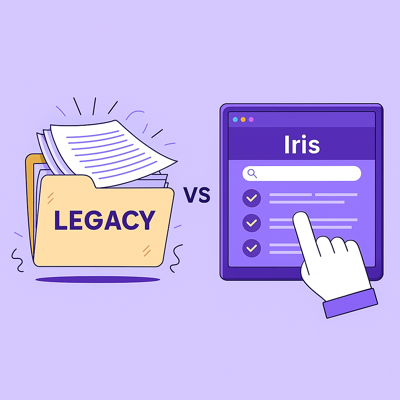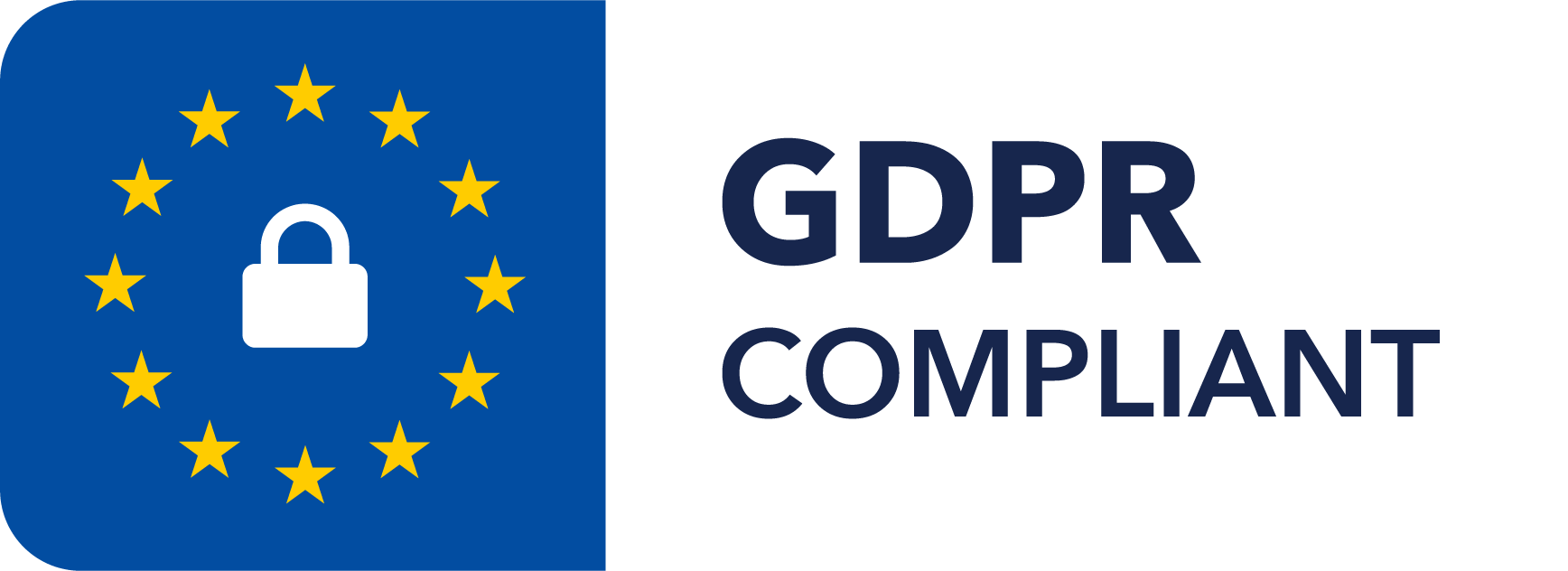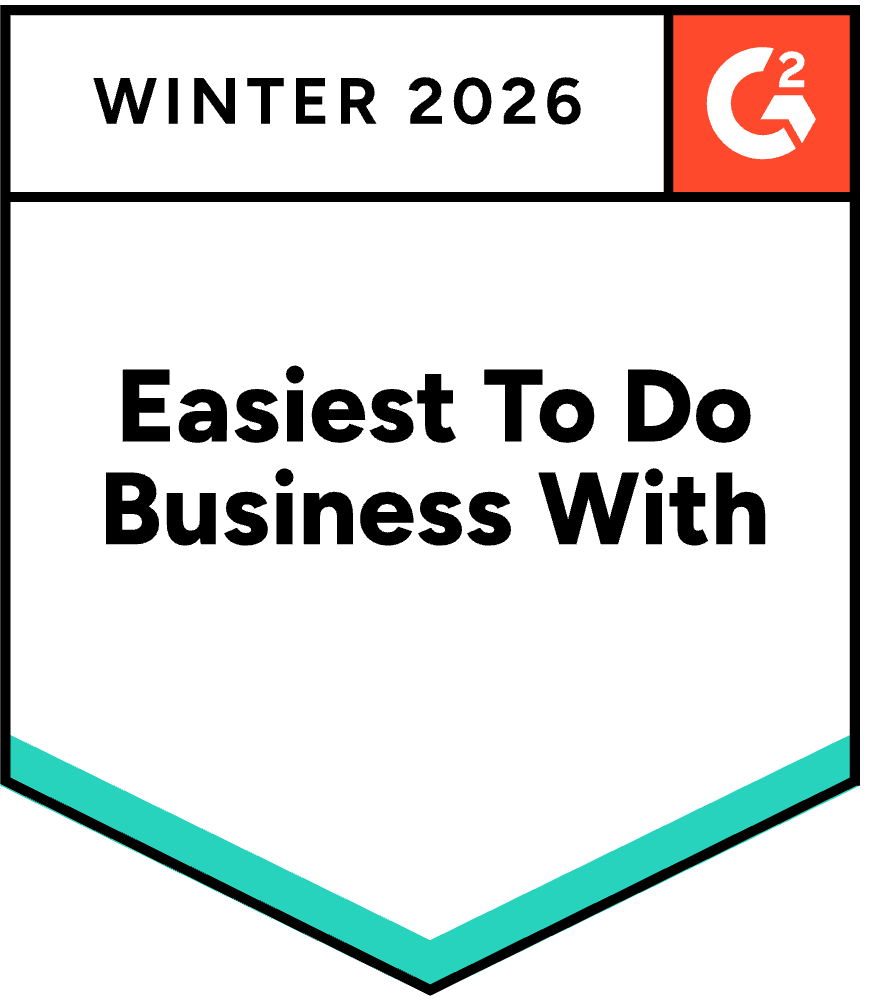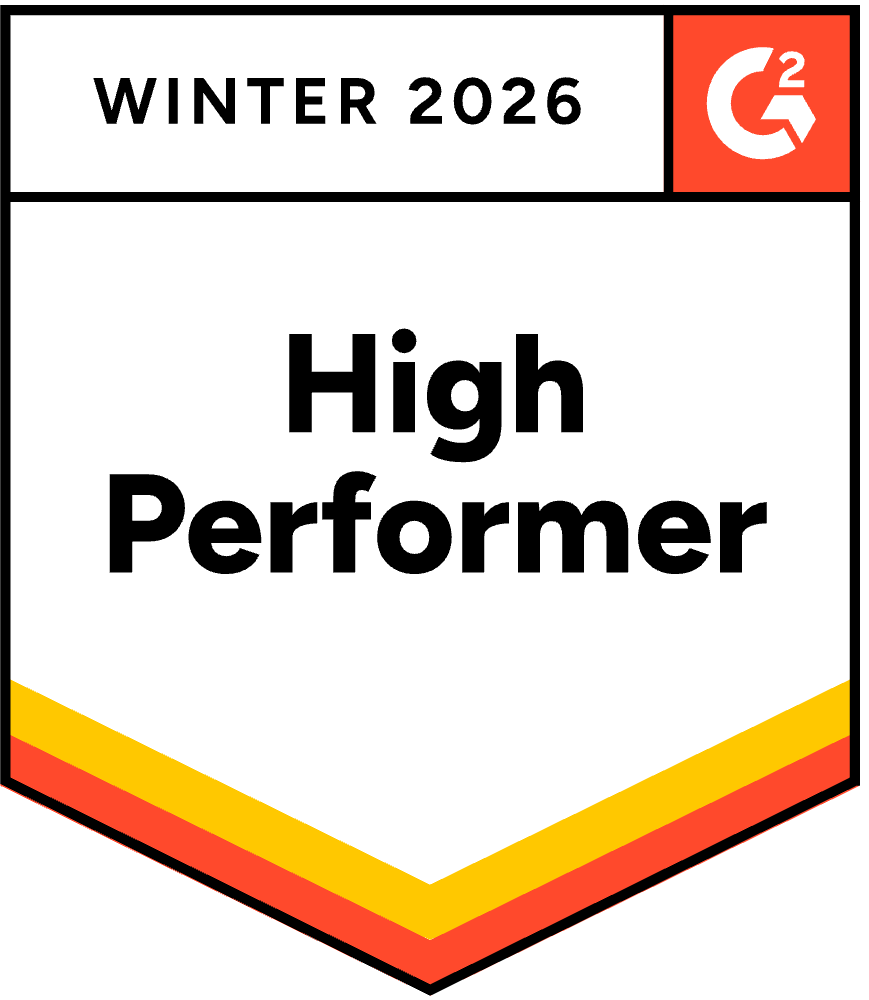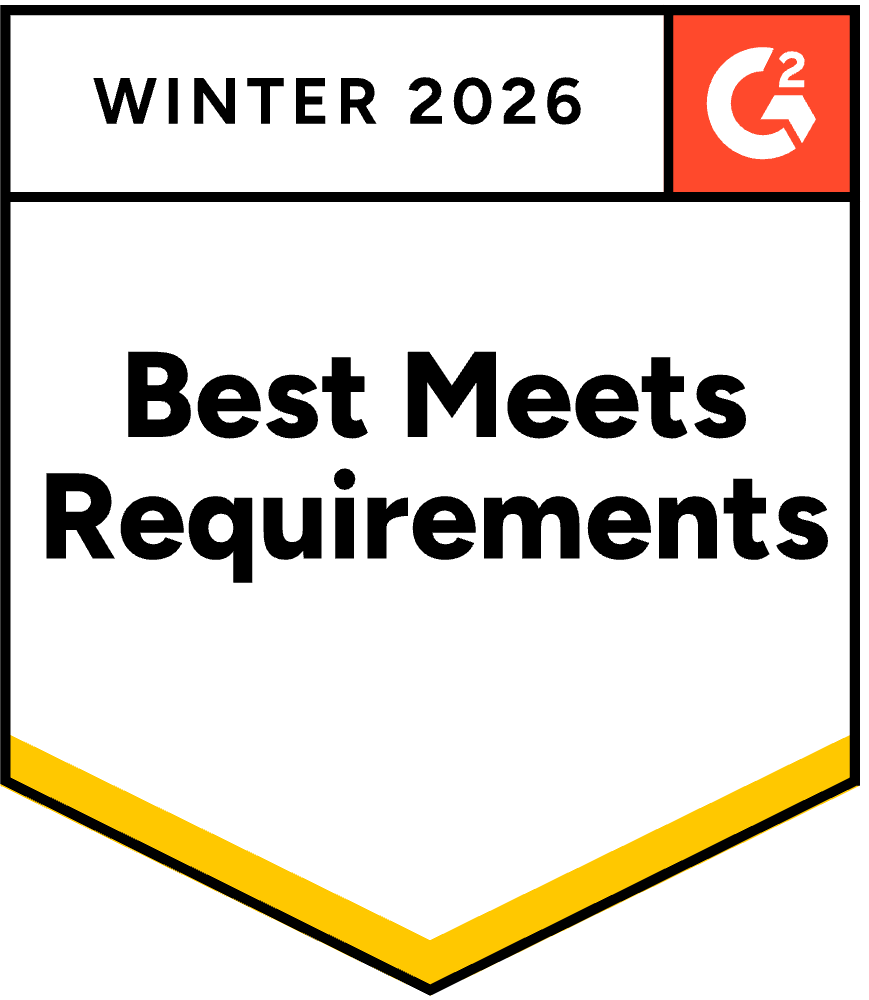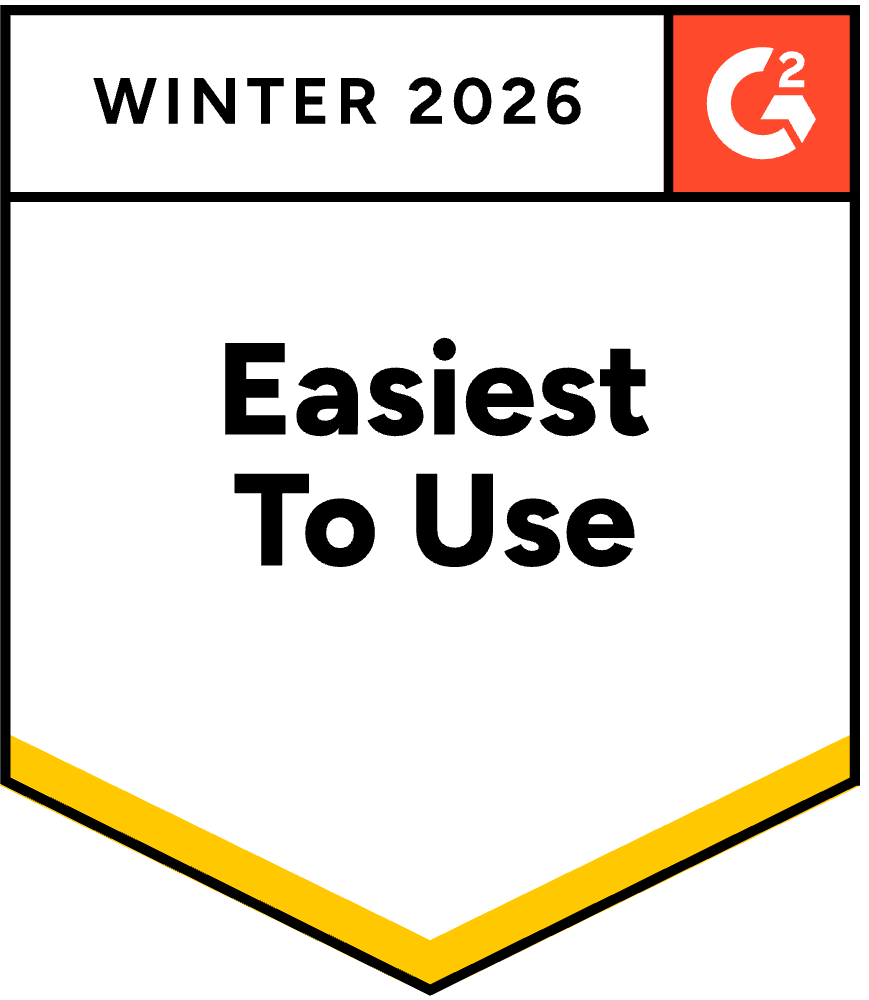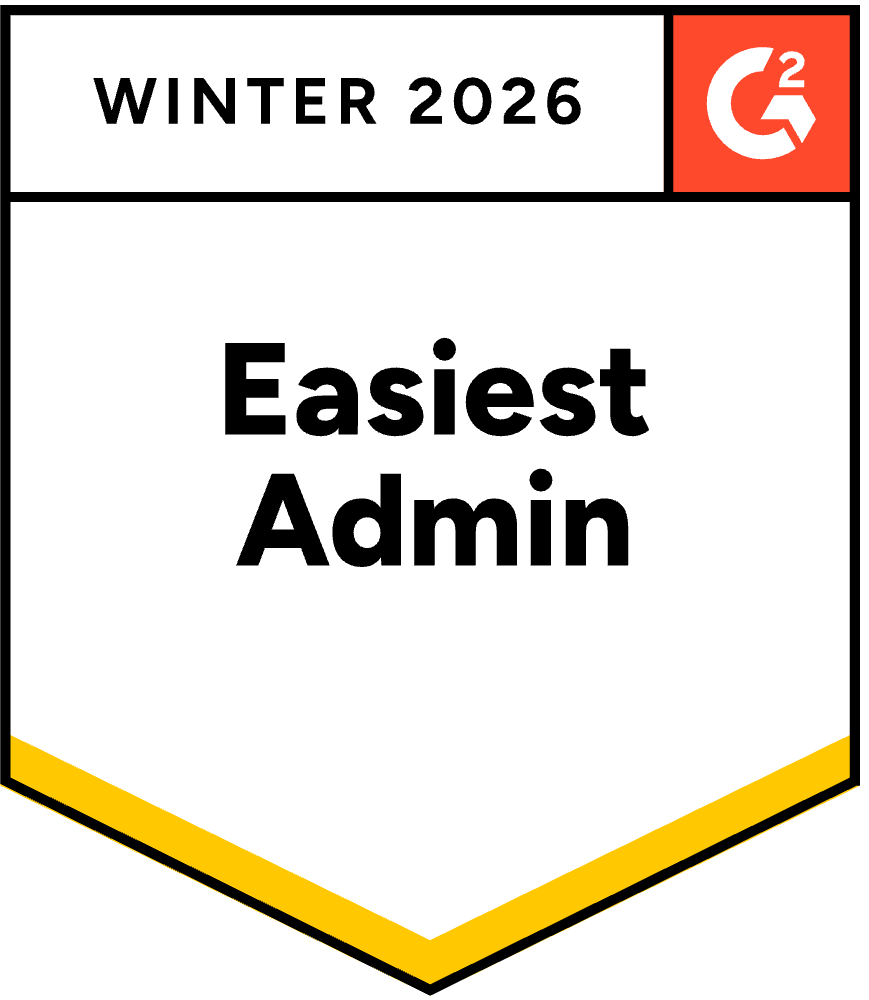Best AI Proposal Software: Top Tools to Streamline Your Sales
August 5, 2025
By
Evie Secilmis
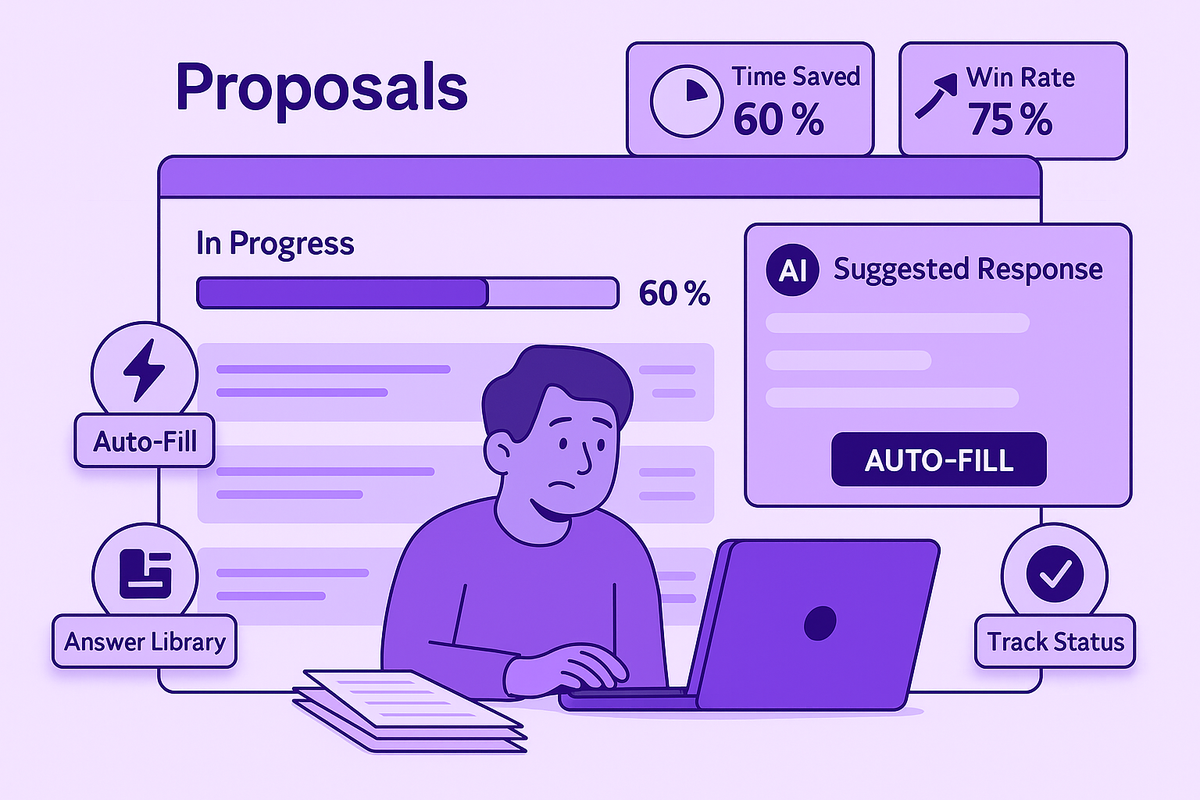
What if your sales team could respond to twice as many RFPs without sacrificing quality? Or cut the time it takes to create a first draft from days down to mere minutes? This isn't just wishful thinking. It's the new reality for teams using AI proposal software. An effective AI sales proposal tool streamlines your entire sales cycle by automating the most tedious parts of proposal creation. Instead of starting from scratch, your team gets a solid, data-driven foundation to build upon. This frees them up to focus on personalization and strategy—the human touches that actually win deals.
Key Takeaways
- Let AI Handle the Repetitive Work: An AI proposal assistant automates the most time-consuming parts of the process, like generating first drafts and finding approved answers. This frees your team to concentrate on high-impact activities like personalizing content and building client relationships.
- A Strong Content Library is Non-Negotiable: The quality of your AI-generated proposals depends entirely on the accuracy of your internal knowledge base. Take the time to build a centralized library of up-to-date, approved content to ensure every proposal is built on a solid foundation.
- Pair AI Efficiency with Human Insight: Use your AI tool to create a compliant, well-structured draft in minutes, but always have your team add the final strategic polish. This partnership ensures your proposals are not only produced quickly but are also persuasive, personalized, and perfectly tailored to win the deal.
So, What Exactly Is an AI Proposal Assistant?
Think of an AI proposal assistant as your team's new secret weapon. At its core, it's a software tool that uses artificial intelligence to help you create business proposals and other critical sales documents faster and better. Instead of starting every RFP or SOW from scratch, an AI assistant does the heavy lifting, pulling together information, structuring the document, and even writing initial drafts for you. This isn't about replacing the human touch; it's about augmenting it. The goal is to handle the repetitive, time-consuming parts of proposal creation so your team can focus on strategy and personalization.
These tools are designed to be a central hub for your proposal process. They connect to your existing systems to ensure every piece of information is accurate and up-to-date. An AI-powered deal desk solution can dramatically cut down the time it takes to respond to RFPs, RFIs, and security questionnaires. By automating the initial grunt work, you free up your experts to add the strategic insights that actually win deals. It’s a smarter way to work, ensuring consistency, accuracy, and speed across every document you send.
How Does AI Actually Help with Proposals?
So, what does an AI proposal assistant do day-to-day? Its main job is to make writing easier. Many tools have an "AI Draft" feature that can generate a complete first draft with just a few clicks, giving you a solid foundation to build upon. It can also help you refine your writing, suggesting better phrasing and ensuring a consistent tone. These assistants are particularly good at saving you time on repetitive tasks.
A core feature is the Content Library, which acts as a single source of truth for your company's information. Instead of hunting through old documents for the right answer, your team can pull approved content directly into a new proposal. This is one of the most practical use cases for AI in proposal writing, as it ensures every response is accurate and consistent.
Why Use an AI Sales Proposal Tool?
The real advantage of using an AI proposal assistant isn't just speed—it's focus. When your team isn't bogged down with tedious, repetitive tasks, they can dedicate their brainpower to what truly matters: crafting a compelling narrative that speaks directly to the client's needs. The AI handles the administrative burden, freeing up your team to think strategically about how to position your solution and differentiate it from the competition. This shift in focus is what ultimately leads to higher-quality proposals.
This focus directly translates into better business outcomes. By streamlining the process, you can respond to more opportunities without sacrificing quality, which helps improve deal volume and win rates. An AI assistant also ensures brand consistency across every document, reinforcing a professional and reliable image with every proposal you submit. It helps you put your best foot forward, every single time.
The Real-World Impact: AI Proposal Software by the Numbers
The shift to AI isn't just about convenience; it's about seeing real, measurable results. Let's look at the numbers. Teams using these tools are seeing a massive reduction in creation time, with some able to build proposals 75% faster than before. In some cases, a complete proposal can be drafted in 17 minutes or less. This incredible speed directly impacts your ability to win. When you can respond that quickly, you get ahead of the competition. In fact, some data shows that 43% of proposals are won within 24 hours of the client opening them. This efficiency translates into serious growth, with businesses reporting up to a 70% increase in new customers. It all comes back to one simple idea: an AI-powered deal desk solution gives your team the time and tools to close more deals, faster.
What Types of Proposals Can You Create with AI?
A good AI proposal assistant is incredibly versatile. It’s not just for one type of document. You can use it to create a wide range of materials, from standard business and sales proposals to highly detailed project plans and statements of work (SOWs). The AI can help you organize your ideas clearly and structure the document appropriately for its specific purpose, whether you're pitching a new client or outlining the scope of a complex project.
These tools are especially powerful for teams that handle complex questionnaires. They can efficiently manage RFPs, RFIs, Vendor Security Questionnaires (VSQs), and Due Diligence Questionnaires (DDQs). Many organizations, from startups seeking funding to nonprofits applying for grants, find these tools invaluable. For instance, government contractors can use an AI assistant to tackle the intricate requirements of a government RFP, ensuring every section is compliant and complete.
Interactive vs. Static Proposals
For years, the standard for proposals has been a static document—think a PDF or Word file. It’s a one-way street: you send it over and hope for the best. The problem is, these documents often make it harder for buyers to make a decision. They’re dense, difficult to share with internal stakeholders, and lack any real engagement. An interactive proposal, on the other hand, functions more like a personalized webpage. It’s a dynamic experience designed to guide your client through the information with elements like embedded videos, clickable case studies, and interactive pricing tables they can adjust themselves.
This approach isn't just about looking modern; it's about effectiveness. Research shows that interactive content is significantly better at capturing and maintaining engagement than static alternatives. When a potential client can actively explore your solution instead of just passively reading about it, they develop a much deeper understanding of its value. This makes it easier for them to champion your proposal internally and confidently make a purchasing decision.
Industry-Specific Solutions
A generic, one-size-fits-all proposal rarely closes a deal. Every industry has its own language, challenges, and priorities. A proposal for a financial services firm needs to emphasize security and compliance, while one for a creative agency should be visually compelling and showcase innovation. An AI proposal assistant excels at this kind of tailoring. By drawing from a well-organized content library, the AI can pull the most relevant case studies, testimonials, and technical specifications for the specific industry you’re targeting.
This allows your team to move beyond static documents and create polished sales collateral that feels custom-built for the client. You can embed an ROI calculator for a SaaS prospect or include detailed compliance documentation for a healthcare organization. This level of customization does more than just answer the client's questions; it demonstrates a deep understanding of their world. It shows you’ve done your homework and are prepared to be a true partner, which is a powerful way to build trust and differentiate your offer from the competition.
How to Choose the Right AI Proposal Software
Key Evaluation Criteria
When you start looking at different AI proposal tools, it’s easy to get distracted by flashy features. But the most important thing to check is the foundation. The effectiveness of any AI assistant is directly tied to the quality of your internal knowledge base. Before you commit to a tool, think about how you’ll manage your content. You need a centralized library of up-to-date, approved answers to ensure every proposal is built on a solid, accurate foundation. Also, consider the vendor's background. A partner with proven experience in your specific industry can offer tailored insights and solutions that a generic tool might miss. They’ll understand your unique challenges and speak your language.
Categorizing Tools by Strength
Not all AI assistants are created equal; they often have different areas where they truly shine. One of the biggest strengths to look for is automation. A great tool automates the most time-consuming parts of the process, like generating first drafts and finding approved answers to common questions. This is what frees your team to concentrate on high-impact activities. Another key area is versatility. Your sales team likely handles more than just standard proposals. Look for a tool that can manage a wide range of documents, from RFPs and SOWs to complex Vendor Security Questionnaires. The more of your workflow it can handle, the more valuable it becomes.
Evaluating Customer Support and Security
The software itself is only half the picture. The support you receive from the vendor is just as critical, especially during implementation. Before making a decision, do your homework. Read reviews, check ratings, and see what current customers are saying about their experience with the support team. You want a partner who will be there to help when you need it. Security is another absolute non-negotiable. You'll be feeding this tool sensitive company and client information, so you need to be confident in its security protocols. Ask potential vendors about their security compliance and data protection measures to ensure your information will be safe.
Our Top Picks for the Best AI Proposal Software
Choosing the right AI proposal assistant feels a lot like picking a business partner—you want one that understands your goals, works well with your team, and makes your life easier. The good news is that there are fantastic options out there, each with its own unique strengths. Whether you’re a fast-moving sales team, a nonprofit writing grants, or a large enterprise juggling complex RFPs, there’s a tool built for you. Let’s walk through some of the best AI proposal assistants available so you can find your perfect match.
| AI Proposal Tool | Best For | Key Features | Strengths |
|---|---|---|---|
| HeyIris.ai | High-volume complex documents (RFPs, RFIs, SOWs) | Automated first drafts, proactive content scanning, connected system integration | Ensures accuracy, saves time, improves win rates, central deal desk intelligence |
| Loopio | Teams focused on content management | AI-powered content library, relevant answer suggestions, automation of repetitive tasks | Centralizes knowledge, ensures consistency, speeds up proposal generation |
| RFPIO | Collaborative teams and SMEs | Machine learning recommendations, content reuse, task assignment, progress tracking | Strengthens collaboration, leverages past proposals, improves response speed |
| Proposify | Teams needing visually appealing proposals | Customizable templates, AI-assisted drafting, analytics tracking client engagement | Professional design, detailed client insights, enhances sales approach |
| PandaDoc | Teams needing full document automation | Proposals, quotes, contracts, e-signatures, real-time collaboration | Streamlines entire sales cycle, integrated system, improved team alignment |
| Grantable | Nonprofits and grant-seeking organizations | Structured templates, AI guidance, narrative building support | Simplifies grant writing, increases funding opportunities, efficient drafting |
| Piktochart | Small businesses, freelancers, teams needing visual impact | AI proposal generator, customizable templates, design-focused | Quick professional-looking proposals, visually engaging, easy to use |
HeyIris.ai
If your team manages a high volume of complex documents like RFPs, RFIs, and SOWs, Iris is designed for you. Think of it as the central brain for your deal desk. What makes Iris stand out is its proactive approach; it doesn’t just help you answer questions, it also scans your connected systems to flag outdated information before it ends up in a proposal. This ensures every response is accurate and consistent. It’s built to dramatically cut down the time it takes to create a first draft, freeing up your team to focus on strategy instead of searching for information. For teams aiming to handle more deals and improve their win rates, Iris provides the structure and intelligence to make it happen.
Loopio
Loopio is a fantastic tool for teams that want to get their content management in order. Its AI-powered platform excels at streamlining the proposal writing process by helping you build and maintain a library of approved content. When an RFP comes in, Loopio suggests relevant, up-to-date answers, which helps you create more accurate and compelling proposals while automating many of the repetitive tasks. If your biggest headache is finding the right information quickly and ensuring consistency across all your responses, Loopio’s AI features for proposal writing are definitely worth a look. It’s a strong choice for centralizing your knowledge and making it easily accessible to everyone on your team.
RFPIO
Collaboration is at the heart of RFPIO. This AI-driven software is built to make teamwork more efficient during the often-chaotic proposal process. It uses machine learning to analyze your past proposals and recommend the best content, which helps your team respond to RFPs much faster. What’s great about RFPIO is how it brings different subject matter experts together in one platform, making it easier to assign tasks, track progress, and get the input you need without endless email chains. If you’re looking for a solution that strengthens collaboration and uses past successes to inform future proposals, RFPIO is a powerful contender that helps your team work smarter, not harder.
Proposify
For teams that want their proposals to look as good as they read, Proposify is an excellent choice. This user-friendly platform integrates AI to help you create visually stunning, professional proposals that capture attention. It offers a gallery of customizable templates, so you don’t have to be a designer to produce a beautiful document. Beyond aesthetics, Proposify provides detailed analytics, allowing you to track when a client opens your proposal, which sections they spend the most time on, and when they sign. This data is incredibly valuable for refining your sales approach and understanding what resonates with your clients, helping you close deals more effectively.
PandaDoc
PandaDoc is more than just a proposal tool; it’s a comprehensive document automation platform that handles everything from proposals and quotes to contracts and e-signatures. Its AI capabilities are woven into a seamless workflow that lets you create, send, and track all your business documents in one place. This is perfect for teams who want to streamline their entire sales cycle, not just the proposal stage. PandaDoc enhances collaboration with features for real-time comments and approvals, ensuring everyone is on the same page. If you’re looking for an all-in-one solution to manage your document workflows from start to finish, PandaDoc offers a powerful and integrated system.
Grantable
Nonprofits and organizations in the grant-seeking world have unique needs, and Grantable is built specifically for them. This AI-powered tool is designed to simplify the often-daunting grant writing process. It provides structured templates, guidance, and AI assistance to help you craft compelling narratives that align with what funders are looking for. Instead of starting from a blank page, Grantable helps you organize your thoughts and build a strong case for your cause. For any organization that relies on grant funding, this specialized assistant can be a game-changer, making it easier to write winning proposals more efficiently and secure the resources you need to make an impact.
Piktochart
If you need to create a professional-looking proposal in a hurry, Piktochart’s AI Proposal Generator is a fantastic resource. Known for its intuitive design tools, Piktochart makes it easy for anyone to create visually engaging documents without needing any graphic design experience. The AI proposal generator offers a range of customizable templates that you can quickly populate with your information. It’s an ideal solution for small businesses, freelancers, or teams that need to produce high-quality proposals that stand out and clearly communicate their value proposition. When you want your proposal’s design to do some of the talking for you, Piktochart provides the tools to do it beautifully and quickly.
Free AI Proposal Generators
Not quite ready to commit to a full-featured platform? That’s completely understandable. If you’re just looking to experiment with AI or need to create a straightforward proposal quickly, a free AI proposal generator can be a great starting point. These tools are often web-based and designed for simplicity. You can use them to generate well-structured, professional-looking documents without a steep learning curve or a budget. For instance, Proposify’s free generator lets you create and customize a branded proposal in just a few minutes, making it ideal for freelancers or small teams needing a fast, polished solution.
However, it's important to recognize the limitations of most free tools. They typically don't offer the deep integration or robust content management features of a dedicated platform. You'll likely still be responsible for manually finding and verifying information, and they can't proactively manage the accuracy of your content library. While they are excellent for simpler, one-off documents, they aren't built to handle the complexity of a high-volume RFP process. Think of them as a great way to test the waters before you need a more powerful, centralized solution to manage your entire deal desk and ensure consistency at scale.
Must-Have Features for Your AI Proposal Software
Not all AI proposal assistants are built the same. When you’re evaluating different platforms, it’s easy to get lost in a long list of features. To cut through the noise, focus on the core capabilities that will actually make a difference for your team’s workflow and win rates. The right tool should do more than just fill in blanks; it should become an integral part of your sales process. From generating smart content to providing actionable insights, here are the essential features to look for in an AI proposal assistant.
Generate Winning Content, Instantly
The most significant advantage of an AI assistant is its ability to generate high-quality content in seconds. Instead of starting with a blank document, your team can produce a complete first draft with the click of a button. Look for a tool with a powerful AI engine that can understand the context of an RFP and pull the most relevant information to create a tailored response. This feature, sometimes called an AI Draft, allows your team to spend less time on tedious writing and more time on strategic tasks like personalization and relationship-building. It’s the difference between assembling a proposal and crafting a winning one.
Build and Customize Your Own Templates
Consistency is key to building a strong brand, and your proposals are no exception. A top-tier AI assistant allows you to create and save custom templates for different types of documents, from RFPs and RFIs to SOWs. This ensures every proposal that leaves your office is polished, professional, and perfectly on-brand. You can pre-load templates with your company’s logos, color schemes, and approved legal language. The AI then uses these templates to structure its generated content, giving you a consistent, high-quality output every time. This saves countless hours of formatting and helps you maintain brand integrity across all your sales documents.
Collaborate with Your Team in Real Time
Proposal writing is a team sport. It often requires input from sales, marketing, legal, and subject matter experts. The last thing you need is a dozen different document versions floating around in email threads. Your AI proposal assistant should function as a central hub for teamwork. Features like simultaneous editing, in-document comments, and clear version control are non-negotiable. These tools ensure everyone is working on the most current draft and can provide feedback efficiently. A platform that supports effective team collaboration keeps projects moving forward smoothly and eliminates confusion.
Connects with the Tools You Already Use
An AI proposal tool shouldn't operate in a silo. To be truly effective, it needs to connect with the other systems your team relies on every day. Look for a platform that offers seamless integrations with your CRM (like Salesforce), cloud storage (like Google Drive or SharePoint), and communication tools (like Slack or Microsoft Teams). This connectivity creates a streamlined workflow, allowing you to pull customer data directly into a proposal or get notified about updates without switching between apps. A well-integrated system like the GovSpend and Iris partnership automates data flow, reduces manual entry, and keeps your entire sales process in sync.
Content Controls to Reduce Errors
We’ve all seen it happen: a proposal goes out with an old logo, an outdated statistic, or a product name from two versions ago. These small mistakes happen when teams are forced to hunt through old documents, copying and pasting content without a reliable way to verify its accuracy. This is where a centralized Content Library becomes your best friend. It acts as a single source of truth, housing all your approved, up-to-date company information in one place. Instead of guessing, your team can pull verified answers directly into a new proposal. This not only saves time but also ensures every document is consistent and accurate, protecting your company’s credibility with every submission.
The best AI assistants take this a step further by actively helping you maintain that accuracy. A static library is only useful if the content within it is current. An intelligent system, like the one powering Iris, can proactively scan your connected systems to identify and flag information that has become outdated. This prevents errors before they even have a chance to make it into a draft. By automating content verification, you ensure every proposal is built on a foundation of trustworthy, current information. This level of control is crucial for reducing risk and making sure your team always puts its best foot forward.
Keep Your Data Secure and Compliant
Proposals often contain highly sensitive information, including your company’s intellectual property and your client’s confidential data. That’s why robust security isn’t just a feature—it’s a fundamental requirement. Your chosen AI assistant must have enterprise-grade security measures in place, such as data encryption, user access controls, and regular security audits. It should also help you adhere to industry-specific compliance standards like SOC 2 or GDPR. Prioritizing a platform with a strong commitment to data privacy gives you and your clients the confidence that your information is always protected.
Track Your Performance with Clear Analytics
How do you know which proposals are hitting the mark and which are falling flat? The answer is in the data. A great AI proposal assistant provides actionable analytics that give you insight into your proposal performance. You can track metrics like which team members are contributing most, how long it takes to complete a response, and, most importantly, your win-loss rates. Some tools even offer document tracking to see if and when a client opens your proposal. These insights help you identify what’s working so you can refine your content, optimize your process, and continuously improve your win rates.
Client Engagement Tracking
Once you hit "send," the waiting game begins. But what if you could see exactly what happens next? Client engagement tracking gives you that visibility. This feature lets you know the moment a client opens your proposal, which pages they read, and how much time they spend on each section. This isn't just about satisfying your curiosity; it's about gaining a strategic advantage. When you see that a prospect has spent a lot of time on your pricing page, you know it's the perfect moment to reach out and address any questions. This kind of insight transforms your follow-up from a shot in the dark to a well-timed, relevant conversation, helping you close deals more effectively.
A Single Source of Truth for Your Content
Stop wasting time hunting for that perfect case study or the latest product spec sheet. A centralized knowledge library is a game-changer for proposal teams. It acts as a single source of truth for all your approved, up-to-date content. The best platforms use AI to make this library even smarter, proactively suggesting the most relevant answers for specific questions in an RFP. An intelligent content management system can also flag outdated information across your entire knowledge base, ensuring every proposal you send is accurate, consistent, and compelling.
Interactive Elements and Mobile Compatibility
Static PDFs are quickly becoming a thing of the past. In a world where everyone is competing for attention, your proposal needs to do more than just present information—it needs to create an experience. Look for a platform that allows you to build interactive proposals with elements like embedded videos, clickable case studies, and dynamic charts. These features increase engagement by encouraging the reader to explore your content rather than just skim it. Equally important is mobile compatibility. Decision-makers review documents on their phones and tablets all the time. A proposal that isn’t optimized for mobile viewing can be a deal-breaker, so make sure your chosen tool ensures a seamless experience on any device.
Electronic Signatures (E-Signatures)
You’ve done all the hard work to get to a "yes." The last thing you want is for the deal to stall because of a clunky signing process. Integrated electronic signatures are a must-have feature that removes the final point of friction in your sales cycle. Instead of asking clients to print, sign, and scan a document, you can let them approve and sign your proposal with a single click from any device. This capability dramatically speeds up the closing process and provides a professional, modern experience for your new customer. It keeps the momentum going and gets you to a closed-won deal faster.
Who Benefits from AI Proposal Software?
AI proposal software isn't a one-size-fits-all solution. Its real power lies in how it adapts to the unique needs of different teams. From fast-moving sales departments to mission-driven nonprofits, here’s a look at how various organizations are using AI to streamline their workflows and achieve their goals.
How Sales Teams Close Deals Faster
For sales teams, time is everything. Instead of spending hours digging for information and piecing together proposals, AI assistants do the heavy lifting. These tools automate the repetitive parts of proposal writing, allowing your team to generate highly customized, on-brand documents in a fraction of the time. This means your reps can respond to more opportunities and focus their energy on building relationships and closing deals. The result is a faster sales cycle and a significant improvement in win rates, turning proposals from a chore into a strategic advantage.
Why Consulting Firms Need AI Proposals
In the competitive world of consulting, being first and being best matters. AI proposal tools give firms a serious edge by helping them get a head start on writing and quickly enhance their drafts. Instead of starting from scratch, consultants can generate a solid first version in minutes, freeing them up to focus on strategy and value proposition. This speed doesn't come at the cost of quality; AI helps ensure every proposal is polished, persuasive, and tailored to the client's specific needs. Adopting this technology early can be a key differentiator, helping your firm stand out from the competition.
Securing Funding for Nonprofits
Nonprofit teams are often stretched thin, wearing multiple hats with limited resources. AI-powered tools, especially those designed for grant writing, can be a game-changer. An AI assistant can transform a blank page into a well-structured draft proposal, saving countless hours of work. This efficiency is invaluable, as it allows your team to move away from tedious administrative tasks and dedicate more time to what truly matters: advancing your mission. By streamlining the grant application process, nonprofits can apply for more funding opportunities and increase their chances of securing the support they need to make a difference.
Helping Startups Win Big Projects
For startups, securing funding is a critical and often constant activity. Whether you're chasing venture capital or applying for grants, the proposal process can be demanding. AI tools help startups create compelling, professional proposals much faster and with less effort. This is crucial when your team is small and every minute counts. By automating the initial draft and ensuring consistency, AI allows founders and their teams to produce higher-quality submissions more efficiently. This gives them a better shot at securing the funding needed to grow and scale their business.
Winning Bids for Government Contractors
Government contracting is a world of its own, with strict rules and complex requirements. Here, AI proposal assistants act as a powerful partner, not a replacement for human expertise. These tools are designed to manage the immense amount of information needed for government bids, like RFPs and RFIs. They help ensure every response is accurate, compliant, and aligned with agency requirements. Purpose-built AI can help you quickly assemble detailed proposals while your team focuses on the strategic elements that win contracts. This combination of AI efficiency and human oversight is key to successfully working with government agencies.
Getting Started: How to Avoid Common Pitfalls
Bringing a new tool into your workflow, especially one powered by AI, can feel like a huge undertaking. It’s completely normal to anticipate a few bumps in the road. The good news is that with a little planning, these challenges are easy to manage. Thinking through potential hurdles ahead of time is the best way to guarantee a smooth rollout and get your team excited about the new software. Let’s walk through the most common implementation questions and how you can address them head-on.
Getting Your Data and Integrations Right
An AI proposal assistant is only as smart as the information you give it. Think of it as a brilliant new team member who needs access to the right files to do their best work. Before you start, take some time to organize your existing content. The AI will pull from your knowledge base to answer RFP questions, so you want to make sure that information is accurate, up-to-date, and easy to find. A great tool will integrate with the systems you already use, but its output depends on the quality of your input. Platforms like Iris can even help by proactively identifying outdated information across your connected systems, ensuring your first drafts are built on solid ground.
How to Get Your Team On Board
It’s natural for people to be a bit wary of new technology. Some on your team might worry that AI is too complicated or that it’s meant to replace them. The best way to get everyone on board is to be transparent and focus on the benefits. Frame the AI assistant as a tool that handles the tedious, repetitive parts of proposal writing, freeing them up for more strategic work. Start with a pilot group to build momentum and share success stories. Providing clear training and showing how the tool directly solves their biggest pain points will transform skepticism into excitement. Seeing how other sales teams have successfully integrated these tools can also provide a powerful example for your own.
Keeping Your Budget in Check
When you see the price tag for a new piece of software, it’s easy to focus on it as just another expense. But with an AI proposal assistant, it’s more helpful to think in terms of investment and return. Consider the number of hours your team currently spends digging for answers, writing boilerplate content, and formatting documents. An AI tool can reduce that time from days to hours. This efficiency doesn't just represent cost savings; it enhances your team's overall capability. When your team can produce higher-quality proposals faster, you increase your deal volume and improve your win rates, delivering a clear return on your investment.
Typical Pricing Tiers
Most AI proposal software is sold on a subscription basis, typically priced per user, per month. While costs vary, you can generally expect paid plans to range from $20 to $75 per user monthly, with a discount if you opt for annual billing. Many companies offer a tiered structure. A free plan might give you access to basic templates with limited features. A personal or starter plan, often around $10-$20 per user, usually adds customization and e-signatures. Business plans, in the $30-$50 range, introduce advanced analytics, CRM connections, and team collaboration features. For larger organizations, enterprise plans offer full customization, top-tier security, and dedicated support, typically costing between $60 and $100 per user.
Using Free Trials and Demos
The best way to know if a tool is right for your team is to see it in action. Nearly every provider offers a free trial—usually for 14 or 30 days—or a live demo. I always recommend taking full advantage of this. This is your chance to kick the tires and see how the software handles your real-world needs. Don't just play with the sample content; upload a few of your own documents and try generating a response to a recent RFP. Invite a couple of team members to test the collaboration features. A hands-on trial will tell you more than a features list ever could. You can schedule a demo to see exactly how an AI assistant can fit into your existing workflow and start making an impact right away.
Staying on Top of Compliance
If you work in a highly regulated industry like finance, healthcare, or government contracting, compliance is non-negotiable. You need to know exactly how your AI assistant handles and processes sensitive data. Before committing to a platform, ask about its compliance certifications, like SOC 2 or GDPR. A trustworthy provider will be transparent about its data handling policies and how it helps you meet your industry's specific requirements. For instance, if you frequently respond to government proposals, you’ll want a tool that understands the unique compliance needs of that sector, like the capabilities offered through the GovSpend and Iris partnership.
Answering the Big Security Questions
Handing your company’s sensitive information over to a new platform can feel risky. Your proposals contain strategic messaging, client data, and financial details that must be protected. That’s why security should be at the top of your checklist. Look for an AI proposal assistant that offers robust security measures as a core part of its service. Essential features to look for include end-to-end data encryption, granular user permissions, and a clear privacy policy. Your AI tool should be a secure vault for your content, giving you full control over who can access and use your company’s most valuable information.
Look for Key Security Certifications (SOC 2, ISO 27001)
While any company can claim to have strong security, certifications are the proof. Think of them as a rigorous, third-party audit that verifies a company’s security promises. When you're evaluating platforms, look for key certifications like SOC 2 and ISO 27001. Achieving SOC 2 compliance, for example, demonstrates that a service provider securely manages your data to protect the interests of your organization and the privacy of its clients. These certifications aren't just acronyms on a feature list; they represent a deep, ongoing commitment to protecting your most valuable information, giving you peace of mind that your proposal data is in safe hands.
Using General AI Tools like ChatGPT for Proposals
While specialized AI proposal assistants offer a streamlined, integrated experience, you can also get started with general-purpose AI tools like ChatGPT. These platforms can be a great way to experiment with AI and see how it can fit into your workflow. They are particularly useful for brainstorming ideas, overcoming writer's block, or drafting initial sections of a proposal. However, getting a high-quality output from a general tool requires a different approach. Unlike a purpose-built platform that already knows its job is to write proposals, a general AI needs very specific instructions to produce something useful. Think of it less as a proposal expert and more as a talented but inexperienced intern who needs clear direction to shine.
How to Write Effective Prompts
The key to getting great results from a general AI tool is mastering the art of the prompt. Vague requests will get you vague, generic content. To get a useful draft, you need to provide as much context as possible. Tell the AI what role it should play (e.g., "Act as a senior proposal writer"), who the audience is (e.g., "the CTO of a mid-sized tech company"), and what the specific goal of the document is. Provide key details, your value proposition, and even a desired tone of voice. While this takes effort, a well-crafted prompt can help you generate a solid first version. This is a more hands-on way of achieving what many specialized tools do with an "AI Draft" feature, which can generate a complete first draft with just a few clicks.
Important Considerations: Fact-Checking and Plagiarism
When you use a general AI tool, you are the final line of defense for quality and accuracy. These models are trained on vast amounts of public data, which means their information isn't always correct or up-to-date. It's essential to fact-check every statistic, claim, and technical detail the AI generates. Even with AI's help, you must add your own ideas and personal touch to make the proposal truly yours. Furthermore, because the AI learns from existing content, you should always run its output through a plagiarism checker before submitting it. This human oversight is critical to protect your company's reputation and ensure the final proposal is accurate, original, and persuasive.
How to Get the Most from Your AI Proposal Tool
Simply buying a new piece of software won't magically transform your proposal process. The real magic happens when you intentionally integrate the tool into your team's daily rhythm. Think of your AI proposal assistant as a new, incredibly talented team member. To get the best results, you need to onboard them properly, give them the right resources, and show them how they fit into the bigger picture. Investing a little time upfront to set up your tool for success will pay off exponentially, saving you countless hours and helping you close more deals down the line.
The key is to move beyond just using the AI for one-off tasks and instead build a system where it becomes the central hub for your proposal operations. When your content is organized, your templates are solid, and your team knows exactly how to leverage the technology, you create a powerful engine for growth. A well-implemented AI deal desk doesn't just speed things up; it introduces a new level of strategy and consistency to your entire sales cycle, ensuring every proposal you send is your best one yet.
Start by Building Your Content Library
Your AI is only as smart as the information you give it. That's why the first and most critical step is to build a comprehensive content library. This is your single source of truth—a centralized, organized repository of all your approved content, from company boilerplate and product specs to case studies and security details. By feeding your AI assistant consistent, up-to-date information, you ensure every proposal it generates is accurate and compliant. A tool like Iris can even help by proactively flagging outdated content across your systems, making maintenance a breeze. This initial setup is the foundation for creating high-quality proposals at scale.
Design Templates That Convert
Once your content library is in order, the next step is to create a set of winning templates. Don't think of these as rigid, one-size-fits-all documents. Instead, view them as strategic starting points for your most common response types, like RFPs, RFIs, and SOWs. By building out a strong template, you standardize your best practices and ensure every proposal starts with a solid, brand-aligned structure. This allows your AI to generate a strong first draft in minutes, freeing up your team to focus on the strategic work of tailoring the proposal to the specific client’s needs, a process that has proven to be a game-changer for our clients.
Set Up Workflows That Actually Work
An AI tool works best when it’s a seamless part of your team’s process, not a clunky add-on. Take some time to map out your ideal proposal workflow from start to finish. Define the stages, assign roles, and clarify where the AI assistant fits in. Who initiates the draft? Who reviews the AI-generated content? Who gives the final approval? Establishing these clear workflows eliminates confusion, prevents bottlenecks, and ensures your team can move quickly and efficiently. This structure empowers your team to collaborate effectively, with the AI acting as a powerful assistant at every step.
Train Your Team to Use the Tool Effectively
To get a real return on your investment, your team needs to feel confident using the new tool. Effective training goes beyond a simple feature walkthrough. Focus on showing your team how the AI assistant makes their jobs easier and helps them achieve their goals. Host hands-on sessions where they can work with the tool on real-world examples. It’s also helpful to identify a few internal champions who can offer peer support and share best practices. When your team understands both the "how" and the "why," they're more likely to embrace the technology and discover new ways to win.
Continuously Improve Your Process
Your proposal process shouldn't be static. To get the most out of your AI tool long-term, you need to adopt a mindset of continuous improvement. Regularly use the tool's analytics to see what’s working. Are certain pieces of content performing better than others? Are there bottlenecks in your workflow? Use these insights to refine your templates, update your content library, and tweak your processes. By regularly optimizing your approach, you ensure your AI assistant evolves with your business, consistently delivering peak performance and value for your team.
Best Practices for Long-Term Success
Choosing the right AI proposal assistant is a great first step, but the real magic happens when you integrate it thoughtfully into your daily operations. Long-term success isn’t about just pushing a button; it’s about building a smarter, more efficient process that evolves with your team. Think of your AI tool as a new team member—one that needs guidance, feedback, and clear goals to perform at its best.
By adopting a few key habits, you can move beyond simply generating drafts faster and start creating consistently winning proposals. These practices will help you refine your content, maintain accuracy, and turn your proposal process into a strategic advantage. The goal is to create a system where your AI assistant and your team work together seamlessly, improving your deal volume and win rates over time. The following tips will help you establish that powerful rhythm from day one.
Personalize Every Proposal
To get the best results from your AI assistant, you need to be specific. The quality of the output is directly tied to the quality of your input. Instead of using generic prompts, provide detailed context for each proposal. Try different ways of phrasing your instructions to see what works best. For example, include information about the client’s specific pain points, their industry, and the key outcomes you want to highlight. The more detailed your prompt, the more tailored and impactful the AI-generated draft will be. Treat it less like a machine and more like a collaborator that needs a clear brief to do its best work.
Put a Quality Control Process in Place
AI is incredibly powerful for creating a solid first draft, but the final polish should always come from a human expert—you. Use the AI to handle the heavy lifting, then step in to refine the details. A great practice is to use the software for a final quality check. AI can help you spot spelling and grammar mistakes, simplify complex technical jargon for a non-technical audience, or adjust the writing style to match the client’s tone. This human-in-the-loop approach ensures your final proposal is not only fast to produce but also accurate, persuasive, and perfectly aligned with your brand’s voice.
Make Compliance Management Simple
Many proposals, especially for government or large enterprise contracts, come with a mountain of rules. From specific formatting requirements and section lengths to mandatory style guides, keeping everything straight is a huge challenge. This is where your AI assistant becomes a compliance powerhouse. A strong AI deal desk solution can be configured to follow these rules automatically, flagging any potential issues before you submit. This saves countless hours of tedious manual review and reduces the risk of having your proposal disqualified over a simple formatting error. It lets your team focus on the substance of the proposal, not the fine print.
Measure What Matters: Tracking Your ROI
How do you know if your proposals are getting better? You have to track your performance. A top-tier AI assistant does more than just write; it provides actionable insights. Use your platform’s features to organize all your proposal content with folders and tags, making it easy to find what you need. More importantly, keep an eye on the analytics. Track the status of your proposals, monitor due dates, and analyze your win/loss rates. Seeing which content snippets are used most often in winning bids helps you understand what resonates with clients, allowing you to refine your strategy with real case study data.
Regularly Update Your Content Library
A common pitfall with any proposal system is a knowledge library filled with stale, outdated information. Your AI assistant can solve this. The best platforms proactively identify outdated content across your connected systems, ensuring your team is always pulling from the most current and accurate information. Furthermore, the AI can learn your organization's unique voice and writing style over time. This ensures that every proposal, no matter who on the team initiates it, sounds consistent and on-brand. This creates a living content library that gets smarter and more effective with every proposal you create, building a foundation for streamlined success.
Related Articles
- AI Proposal Management Software That’s Built to Scale
- The RFP Dilemma: Why It’s So Painful
- 10 Ways to Use AI for Better Bid Writing
- How Generative AI Will Win You More RFPs
- AI RFP Automation for Enterprise Sales
Frequently Asked Questions
Will an AI proposal assistant replace my job as a proposal writer? Not at all. Think of it as a powerful collaborator, not a replacement. The goal of an AI assistant is to handle the most repetitive and time-consuming parts of the job, like finding approved answers or formatting documents. This frees you up to focus on the high-value work that actually wins deals—like crafting a compelling strategy, personalizing the narrative for the client, and ensuring the proposal truly solves their problem. The AI provides the foundation, but your expertise provides the winning edge.
How do I ensure the AI's writing sounds like my company and not a robot? This is a great question, and it gets to the heart of using these tools effectively. The key is to treat the AI-generated text as a solid first draft, not the final product. You can guide the AI by feeding it a well-maintained content library filled with your best, on-brand material. The tool learns from your content. After it generates a draft, your team steps in to refine the tone, add specific insights, and ensure the voice is perfect. It’s a partnership where the AI does the heavy lifting and you provide the essential human touch.
Is my company's sensitive proposal data safe with an AI tool? Security is a top priority, and any reputable AI proposal platform will treat it that way. These tools are built with enterprise-grade security measures, such as data encryption both in transit and at rest, and strict user access controls. Before choosing a platform, you should always review its security and compliance certifications, like SOC 2. A trustworthy provider will be transparent about how they protect your information, giving you the confidence that your strategic content and client data are secure.
How much effort does it really take to get started? The initial setup is the most important part, and it's worth doing right. The main task is to organize your content into a centralized knowledge library. This means gathering your best case studies, product descriptions, and approved answers so the AI has high-quality information to work with. While this requires some upfront effort, a good platform makes the process straightforward. Investing this time at the beginning pays off immensely, as it enables the AI to produce accurate, high-quality drafts in minutes for every proposal that follows.
We handle more than just RFPs. Can this kind of tool still help us? Absolutely. While these tools are fantastic for RFPs, their versatility is one of their biggest strengths. You can use an AI assistant to create a wide range of business documents, including Statements of Work (SOWs), security questionnaires (VSQs), Due Diligence Questionnaires (DDQs), and standard sales proposals. The ability to create custom templates for different document types means you can bring speed, consistency, and quality to your entire sales and business development process, not just one part of it.
Share this post
Link copied!




